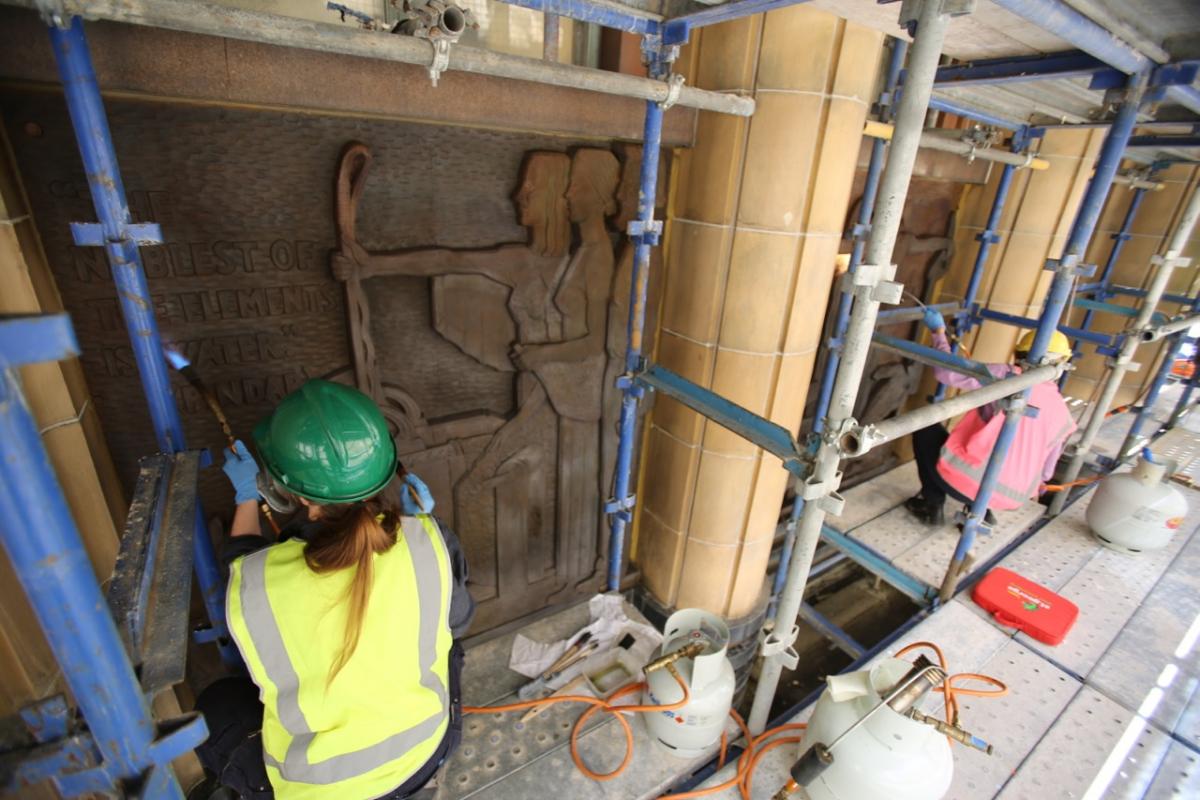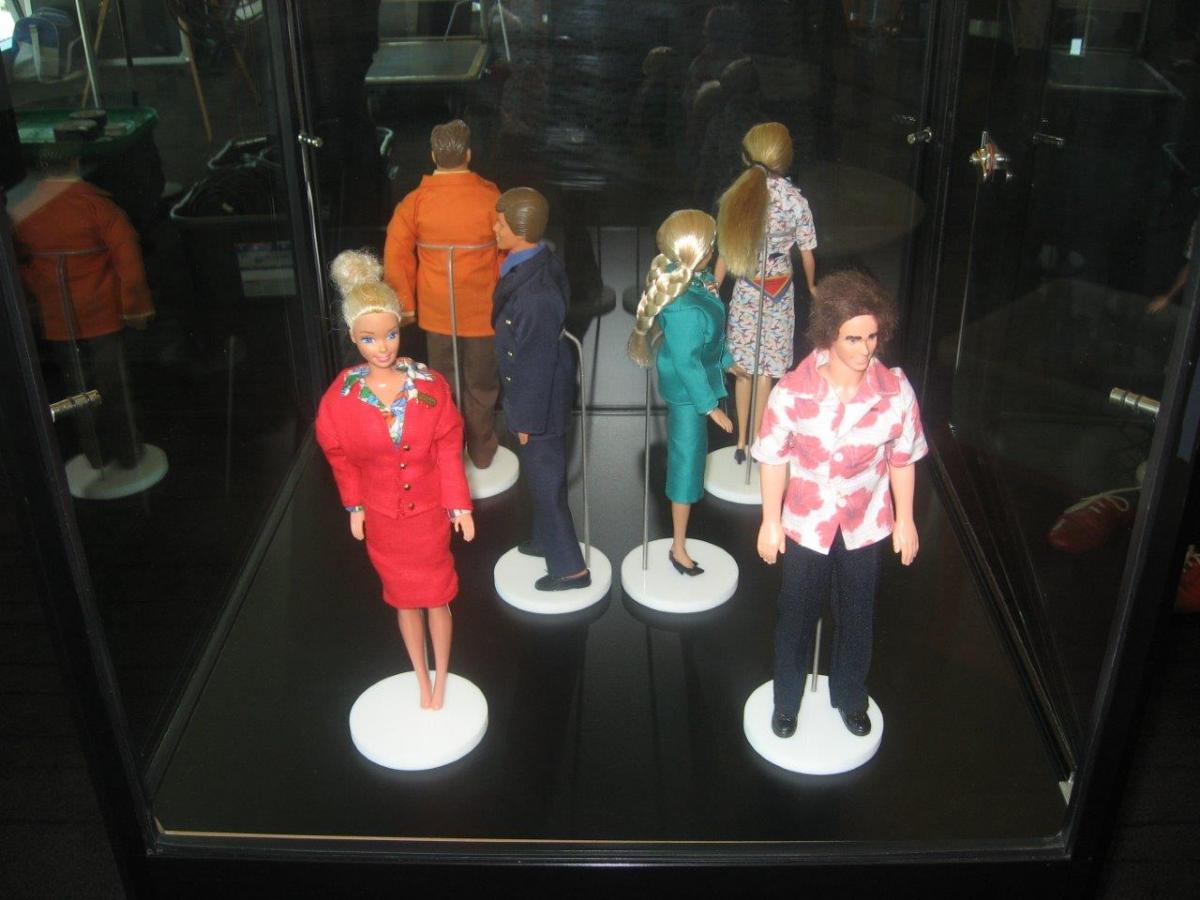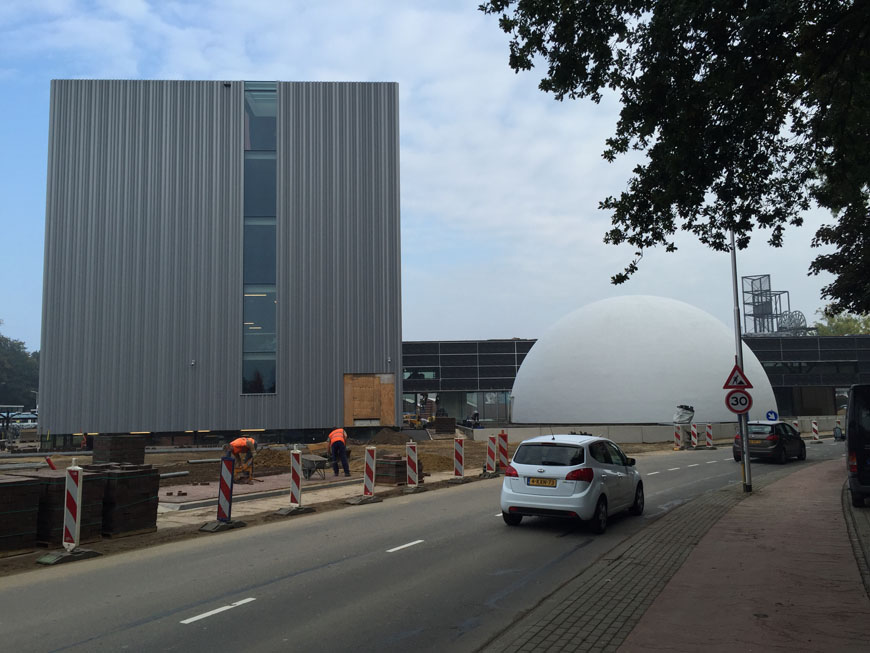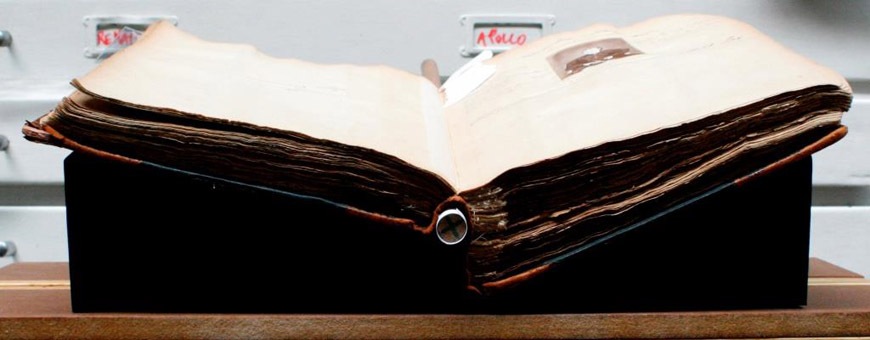Sydney Artefact Conservation
PROJECTS
The team at Sydney Artefacts Conservation have had an interesting and diverse range of object treatments and collection management projects throughout September and October. Recent work includes the stabilisation and cleaning of the kinetic sculpture Proteron by Dennis Wilcox for the Museum of Contemporary Art and treatment of a selection of archaeological artefacts unearthed during recent excavations at 478 George Street, Sydney. These objects were subsequently installed by Anne Cummins into an exciting display that interprets some of the history of the site.
Sydney Artefacts Conservation was contracted to work on the bronze bas reliefs, three storeys up, on the facade of the former Water Board building on Pitt Street, Sydney. Anne Cummins and Cecilie Knowles conserved the Art Deco triptych by Stanley J. Hammond (see image) which had not been treated since its installation in c1939.

University of Canberra student Jessica Goodvin assisted Anne Cummins on two recent collection management projects. She helped conduct inventory and condition recording as part of the Collection Management Plan for Roto House, Port Macquarie. She also assisted Anne with the building survey and recording of light readings for a Preservation Needs Assessment of the Historical Collection at La Perouse Museum.
Museum of Applied Arts and Sciences
PROJECTS
Building of a multi-storey shared object storage facility at Castle Hill is due to be completed in January 2016 with racking installed and hand-over in April 2016. The redevelopment also includes two new conservation clean rooms and a refurbished and extended display centre (called the Museums Discovery Centre). The new buildings and facilities are shared between MAAS, the Australian Museum, and Sydney Living Museums.
The Discovery Centre will be open to the public for self-guided visits, while occasional open days will enable guided tours through other buildings on site and provision of demonstrations and other activities.
EXHIBITIONS
The conservation team has been working on a number of exhibitions and outward loans over the last few months. Most recently, Suzanne Chee prepared costumes and dressed approximately 90 mannequins for the Collette Dinnigan – Unlaced exhibition which opened in September.
Skye Mitchell, Rebecca Ellis and Tim Morris worked with the team from the Victoria & Albert Museum on the install of the V&A exhibition Disobedient Objects which opens to the public on the 31st of October. The conservation team were ably assisted by our volunteer John Cooper.
Gosia Dudek, Teresa Werstak, Rebecca Main, Skye Mitchell, Tim Morris, Rebecca Ellis, Suzanne Chee and Carey Ward worked on preparing objects, supports and installation for the Brooke Andrews art installation Brooke Andrews: Evidence which opens to the public on the 31st of October.
Assisting the core conservation team in the making and adapting of support material which surrounds the MAAS objects as part of the art work were Kate Chidlow and Vanessa Pitt. Sue Gatenby also researched the effects and use of neon lighting for the museum objects in the installation.
LOANS

Frances Fitzpatrick and Vanessa Pitt have been working on many outward loans. Most recent projects include the preparation and installation in the Sydney Qantas Club of 42 Barbie and Ken dolls dressed in miniature Qantas uniforms for an exhibition celebrating Qantas’ 95th anniversary. The doll outfits were modelled on those worn by Qantas flight attendants and pilots over the decades and were made by a previous employee of Qantas, John Willmott-Potts, who worked as a flight attendant for the company. Mr Willmott-Potts created his collection between 1988 and 2010, and donated them to MAAS shortly before his death in 2010.

Another recent loan that Frances Fitzpatrick and Vanessa Pitt prepared objects and supports for, as well as compiled detailed installation/deinstallation and packing guides, was delivered and installed in October by Conservation Manager Jonathan London at the brand new Cube Design Museum in Kerkrade, The Netherlands. The objects are being displayed as part of Cube Design Museum’s inaugural exhibition, Design for Human Needs – Worldwide. The exhibition and the new museum opened on the 23rd of October.
The Cube Design Museum is part of an expansion of the existing Continium Discovery Centre, and is one of two new facilities along with the Columbus Earth Theatre. A freely accessible public space, ‘ C-Square ‘, connects the venues.
Continium remains the place where visitors discover what science and technology mean for everyday life. Not only today, but also in the past and in the future. Cube explores developments in the malleable world on the basis of varying design exhibitions and Design Labs. Columbus is an environment where visitors see and experience how the world looks, but also what’s going on with our Earth and how we affect her with our actions.
RESEARCH
Vanessa Pitt condition checked, and conservation photographer Michael Myers photographed 15 Japanese swords, a Chinese vessel and original and reproduction Sydney Harbour Bridge rivets from the MAAS collection in preparation for a research loan to the Australian Nuclear Science and Technology Organisation (ANSTO). Sue Gatenby delivered the objects to ANSTO in October. Analysis of the objects will include the use of two complex machines – DINGO and KOWARI – which read neutron tomography and neutron diffraction respectively. ANSTO hopes to use the advanced technology to reveal some of the secrets about the individual object manufacturing techniques.
Sue Gatenby provided cellulose acetate samples from the MAAS collection to the Getty Conservation Institute for analysis as part of their GCMS method for their research project calculating percent acetyl content in cellulose acetate.
Preservation Australia and Conservation Resources
TREATMENTS
Kay Söderlund treated a wonderful artwork by Korean artist Kwang Young Chun. The work was essentially a paper sculpture consisting of thousands of very small pieces of Styrofoam wrapped in Korean mulberry paper with black ink lettering creating concentric circles. The owners have the work attached to the ceiling above their bed! The object had become stained from a water leak and the treatment was a simple but time-consuming one – high pH deionised water locally applied. The area was then dried with blotter allowing the stain to migrate into the blotter.
Kay also completed the treatment of the iconic Slim Dusty’s suitcase, which was then installed in the new Slim Dusty Centre in Kempsey. The treatment involved stabilization and support of the old, battered suitcase.
Tegan Anthes and Beate Yule completed treatment of nine Norman Lindsay prints and a historic photograph album from Port Macquarie. The album was fractured and embrittled and each page was strengthened with tengujo. The prints all required tape and backing removals and re matting.
WORKSHOPS AND CONFERENCES
Kay, Beate and Tegan all attended the one day seminar on Preservation of Digital Prints and Contemporary Colour Photographspresented by Martin Jürgens at the Art Gallery of NSW. Teganwent on to attend the week-long intensive program (with a broken leg) with a small group of conservators. The depth of information that Martin shared was invaluable.
Preservation Australia recently conducted a week-long workshop for the National Trust – Norman Lindsay Gallery on disaster planning and recovery. Kay worked with National Trust staff and volunteers for four days, with a final day dedicated to the residents of the Blue Mountains.
International Conservation Services
PROJECTS
The diverseness (and richness) of the conservator’s life has been amplified for ICS over the last few months with our services being required in diverse ways and diverse places.
Internationally, the Saruq al Hadid archaeological project in the UAE has now reached the end of year one of three, with a lab now established in Dubai and seasonal work at the dig site 80kms South East of Dubai. Amy Crossman from the UK and Jeff Fox from Melbourne are permanently there, and Karina Acton as the technical supervisor makes regular visits.
Meanwhile, four ICS projects are progressing in New Zealand, with two teams working at the Canterbury Museum, Christchurch on earthquake remediation projects, Nick Flood and Bronwyn Tulloh on the dioramas and Skye Firth and Gail Hamilton on the textiles. Julian Bickersteth spent three days at MOTAT in Auckland working with David Crotty, the QANTAS Heritage Centre curator, assessing two vast flying boats and developing conservation management plans for them. And in Wellington, the Treaty of Waitangi permanent exhibition planned for the National Library of New Zealand is entering its next phase of development. Finally, back again in Christchurch, Julian Bickersteth is wrapping up the reporting and sign off on the Ross Island, Antarctica Hut Restoration Project. Involving 62 conservators including seven Australians over 10 years, and conserving over 20,000 artefacts, the project has been an outstanding success, and will continue to employ conservators during the summer season to undertake housekeeping, maintenance and monitoring works.
Back in Australia, we have had teams working on a number of large projects. The paper conservation team (Eliza Penrose, Wendi Powell and Katie Wood) are engaged on the smoke remediation of a large sheet music collection, and have also been lucky enough to have had several beautiful Japanese Screens to repair and consolidate.
The paintings conservation team (Matteo Volonté, Celine De Courlon and Claire Heasman) have been enjoying the challenges of recovering a collection of paintings that had been stored rolled and folded up for years. Lots of flattening, stretching, consolidation and inpainting have achieved some amazing results.
We have also been involved in a project for Tomago House in Raymond Terrace, a National Trust property that had suffered significant damage to its interiors. Arek Werstak and Oliver Hull have been working on remediation and conservation of the plaster and wooden finishes inside the house, whilst our paper and textiles conservation teams have also been involved with treating a number of smaller pieces from the collection.
Our objects and outdoor heritage team have recently welcomed Eoin O’Suilleabhain into the team in the new position of Conservator / Conservation Projects Manager. He has been assisting with various maintenance contracts on sculpture and memorials for the City of Sydney and UNSW. Katy Ross has been overseeing the ATP bell tower refurbishment works and undertook an inspection of two guns at Jezzine barracks in Townsville, QLD.
Meanwhile, various members of the team have been repainting inscriptions on a group of marble tablets ready for their reinstallation at Concord War Memorial, and Bronwyn Tulloh has been working on rehousing of an ethnographic collection at the Reserve Bank of Australia.
Adam Godijn worked with a team of conservators from ICS with additional fresh faces including William Sit, Eliza O’Donnell, Lucy Tedder and Oskar Slifierz on some challenging contemporary artworks.
Elwing and Gurney Archival
TREATMENTS
Jill Gurney has been preparing a frail early 20th Century criminal register for an exhibition in December at the National Portrait Gallery. With rotted leather and inappropriately bulky guards, the volume is its own worst enemy. Minimal intervention was requested.
 Jill has concentrated repairs around the peeling and lifted areas of the tight back leather spine. Laying the detached leather down over applied spine paper linings and reinforcing the exposed joints where possible.
Jill has concentrated repairs around the peeling and lifted areas of the tight back leather spine. Laying the detached leather down over applied spine paper linings and reinforcing the exposed joints where possible.
The spine has been selectively lined, and leather re-adhered. Damaging guards from an earlier repair are visible.
James Elwing has produced a shaped support based on the opening position and 200mm high case height restriction.
The support, of black acid free foam core, conforms to the desired display page position. The volume has a separate central spine roll to reduce spine stress, hidden in display.